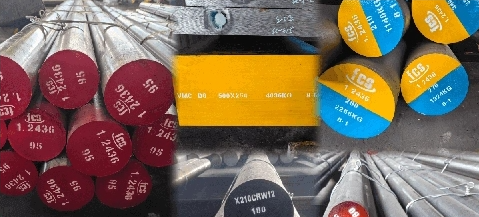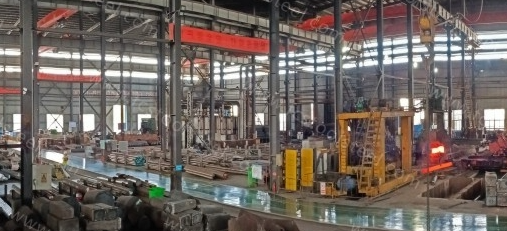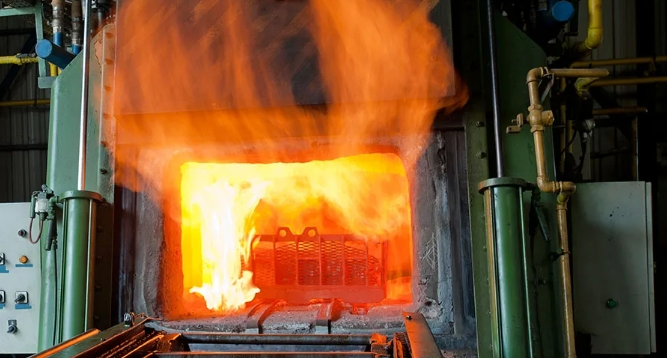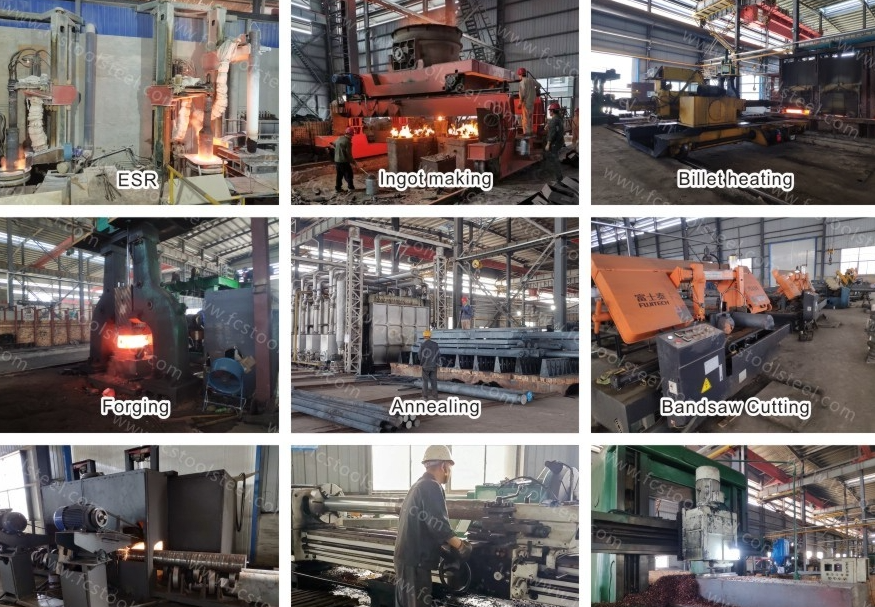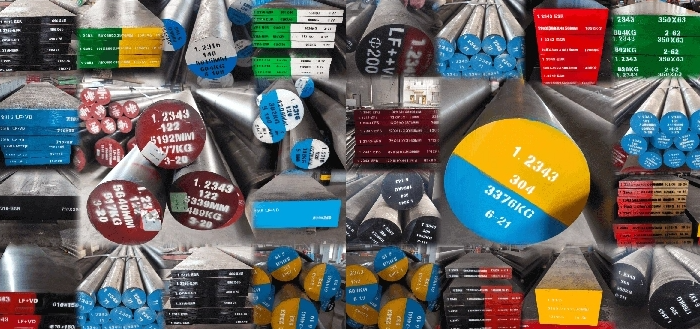Introduction to 1.2436 Tool Steel
1.2436 Tool Steel, or H13(cold work tool steel) .It is my first choice for extreme temperatures and heavy workloads. I have seen how well this steel performs in die-casting and forging. It resists thermal fatigue effectively. Its composition includes carbon, chromium, molybdenum, and vanadium, giving it toughness and hardness. It maintains its edge even when heated. This steel is reliable and does not bend under pressure. It remains strong and durable at any temperature. I trust it to minimize deformation and wear, even in high heat conditions.
Applications of 1.2436 Tool Steel
1.2436 steel(cold work tool steel) is known for its strong wear resistance and dimensional stability. It is a popular choice for many tooling applications. This steel is commonly used in industries that need precision and durability. It is especially used for high-performance cutting, forming, and molding tools.
Common Applications:
The steel is also perfect for forming dies used in stamping and deep drawing processes, especially for stainless steel and aluminum components. Additionally, it plays a critical role in cold extrusion tooling, serving as dies and punches for the cold extrusion of metals. Furthermore, 1.2436 tool Steel is used in thread rolling dies for producing threaded components, as well as in woodworking tools like planer knives and paper cutting knives. It finds application in measuring tools for the creation of gauges and masters that require precise measurements. The steel’s high wear resistance also makes it suitable for plastic molds and rolls used in cold rolling mills.
Specific Examples:
Specific applications of 1.2436 Tool Steel(cold work tool steel) include blanking dies for electrical steel laminations, fine blanking punches and dies, cold heading dies, coining dies, bending dies for tube and wire, trimming tools for forgings, knurling tools, and rotary slitting cutters.
1.2436 tool steel(cold work tool steel) is especially valuable for high-precision tooling that demands moderate impact resistance. Its ability to perform effectively with harder materials, such as stainless steel, ensures its place in industries requiring reliable and durable tooling solutions.
Heat Treatment of 1.2436 Tool Steel
Heat treatment is crucial for optimizing the mechanical properties of 1.2436 tool steel(cold work tool steel) , such as hardness, wear resistance, and dimensional stability. The following processes are commonly used for heat treatment:
Heat Treatment of 1.2436 Tool Steel(cold work tool steel) involves several critical processes to achieve desired material properties. Annealing requires heating the steel to a temperature range of 800-850°C, followed by soaking for one hour per 25mm of thickness and then slowly cooling in the furnace, resulting in a hardness of 250-255 HB. For Stress Relieving, the steel is heated to 600-650°C and held for one hour to air cool, reducing distortion that may occur during subsequent treatments. The Hardening process begins with preheating the steel to 750-800°C, followed by austenitizing at 940-980°C for 15-30 minutes, then quenching in oil, air, or a warm bath at 500-550°C. Upon completion of hardening, Tempering should be performed immediately, with varying temperatures yielding different hardness levels: 100°C results in 63 HRC, 200°C in 62 HRC, 300°C in 60 HRC, 400°C in 58 HRC, 500°C in 56 HRC, and 600°C in 48 HRC, while double or triple tempering is recommended, holding for one hour per 25mm of thickness each time. Lastly, Forging involves slowly heating the steel to 700°C before rapidly raising the temperature to between 900-1050°C, after which it should cool slowly in the furnace.
Technical Specifications of 1.2436 Tool Steel
1.2436 tool steel(cold work tool steel) , also known as a high-carbon, high-chromium cold work tool steel, boasts a range of impressive technical specifications, making it suitable for various industrial applications.
1.2436 tool steel(cold work tool steel) has a typical chemical composition that includes 2.00-2.30% carbon, 11.00-13.50% chromium, 0.60-0.90% tungsten, and trace amounts of silicon and manganese (≤0.60%). Its physical properties further enhance its performance, showcasing a density range of 7.67-7.85 g/cm³, a thermal expansion coefficient of 10.8-10.9 x 10^-6 /K (from 20-400°C), thermal conductivity between 16.7-20.5 W/m·K, and a specific heat capacity of 0.46 J/g·K. When appropriately heat-treated, 1.2436 steel demonstrates mechanical properties such as a maximum hardness of 225-250 HB after annealing and an achievable hardness of 58-64 HRC. Optimal heat treatment parameters entail an annealing temperature of 800-840°C, hardening temperature of 950-980°C, and tempering temperature of 180-250°C for attaining the desired hardness. Key characteristics of 1.2436 steel encompass very high wear resistance, good dimensional stability, high compressive strength, moderate toughness, excellent edge-holding ability, and the distinction of not being secondary hardenable.
Equivalent grades to 1.2436 tool steel
When choosing tool steel for your manufacturing needs, it’s important to understand the differences between various grades. Here’s how 1.2436 /X210CrW12 tool steel (cold work tool steel) compares to other commonly used tool steels:
Standards and Classification
SKD2 (JIS) and X210CrW12/1.2436 (DIN) are cross-standard equivalents. Cr12W (GB) is the Chinese counterpart. D6 (AISI) overlaps with DIN 1.2436 and is commonly used in the North American market. The XW-5 and K107 are optimized for manufacturers and may be enhanced by special processes (e.g. wear resistance, resistance to annealing).
| Grade | standardized system | classify | Correspondence |
|---|---|---|---|
| SKD2 (JIS) | Japen JIS | Cold work tool steel | Corresponding to DIN 1.2436, AISI D6 |
| D6 (AISI) | U.S.A AISI | Cold work tool steel | Equivalent to DIN X210CrW12/1.2436 |
| Cr12W (GB) | China GB | Cold work tool steel | Approximate DIN 1.2436, JIS SKD2 |
| X210CrW12/1.2436 | Germany DIN | Cold work tool steel | Conforms to ISO 4957 for versatility |
| XW-5 (ASSAB) | Sweden ASSAB | High wear-resistant cold work tool steel | Manufacturer’s proprietary grade with properties close to 1.2436 |
| K107 (Böhler) | Austria Böhler | Cold work tool steel | Manufacturer’s proprietary grade, possibly similar to D6 |
Chemical Composition Comparison
SKD2(cold work tool steel) , Cr12W, X210CrW12/1.2436. Compositions are highly similar, with the main difference being the standard nomenclature.XW-5 (ASSAB) has a slightly higher tungsten content and enhanced wear resistance.K107 (Böhler) is a manufacturer’s proprietary grade and may be close to DIN 1.2436, but specific data should be referred to the manufacturer’s literature.
| Grades/Standards | C (%) | Cr (%) | W (%) | V (%) | Other Ingredients |
|---|---|---|---|---|---|
| SKD2 (JIS) | 1.90~2.2 | 11~13 | 0.5~1.0 | ≤0.3 | Mn: 0.2~0.6; Si: 0.1~0.6 |
| D6 (AISI) | 2.05~2.4 | 11~13 | 0.5~1.0 | – | Similar to Cr12W series |
| Cr12W (GB) | 1.90~2.2 | 11~13 | 0.6~1.0 | ≤0.3 | Similar composition to SKD2/X210CrW12 |
| X210CrW12/1.2436 (DIN) | 1.90~2.2 | 11~13 | 0.6~1.0 | ≤0.3 | Equivalent to ISO 4957 cold work tool steels |
| XW-5 (ASSAB) | 2.1~2.4 | 12~13 | 0.6~1.2 | – | High carbon, high chrome tungsten, outstanding wear resistance |
| K107 (Böhler) | ~2.1 | ~12 | ~1.0 | – | Not explicitly labeled, presumably similar to DIN 1.2436 |
Performance and Application Differences
XW-5 is superior to general-purpose grades in wear resistance and temper softening resistance due to its high tungsten content. SKD2 and D6 are suitable for medium load scenarios. XW-5 and K107 are more suitable for high precision and long life.
| Grades | Hardness (HRC) | Core characteristic | Typical application scenario |
|---|---|---|---|
| SKD2/D6 | 60~62 | High hardness, wear resistance, medium compressive strength | Blanking die, cold cutting die, precision tool |
| Cr12W/1.2436 | 60~62 | Excellent wear resistance, good tempering stability | Cold extrusion die, stamping die, measuring tool |
| XW-5 (ASSAB) | 62~64 | Excellent wear resistance, high temperature softening resistance | High load cold mold, precision punch |
| K107 (Böhler) | ~62 | High toughness, suitable for complex working conditions | High precision cold forming die, cutting tool |
Choose the steel grade that best aligns with your specific application needs.
Quality Inspection Reports
Quality inspection reports for 1.2436 steel are crucial for ensuring that the material meets the required standards. These reports generally include the following essential test results:
The analysis of 1.2436 steel includes important evaluations to ensure its quality and performance. The chemical composition meets certain standards: carbon (2.00-2.30%), chromium (11.00-13.00%), tungsten (0.60-0.80%), silicon (0.10-0.40%), and manganese (0.30-0.60%). After heat treatment, mechanical testing shows the following properties: hardness (58-62 HRC), tensile strength (1900-2100 MPa), yield strength (1600-1800 MPa), and elongation (1-2%). A microstructural examination checks for uniform carbide distribution, no excessive grain growth, and no major defects or inclusions. Dimensional checks ensure accuracy within specific tolerances: diameter/thickness at ±0.1 mm, length at ±1 mm, and flatness at 0.2 mm/m. Non-destructive testing methods, such as ultrasonic testing and magnetic particle inspection, are used to find internal and surface flaws. Lastly, the heat treatment parameters are confirmed. The hardening temperature is set at 960-1000°C, with quenching options including oil or air, and the tempering temperature is between 180-220°C.
Manufacturers should provide a Certificate of Conformity summarizing all these results, ensuring that the steel meets the specified requirements for 1.2436 steel.
Advantages and Limitations of 1.2436 Steel
Advantages
1.2436 steel has many benefits that make it suitable for various industrial uses. It has excellent wear resistance because of its high carbon and chromium content. After heat treatment, it achieves a hardness of 58-62 HRC, which increases its durability. This steel also maintains its shape during heat treatment, ensuring consistent performance. It has high compressive strength, allowing it to handle high-pressure situations. Lastly, it can be easily machined when annealed, which helps in efficient production processes.
Limitations
Despite its advantages, 1.2436 steel has certain limitations, including poor impact toughness, which makes it more brittle under high impact compared to other tool steels. It also has limited secondary hardening capabilities following the initial heat treatment, and lower toughness than similar grades, such as 1.2379 steel. Furthermore, 1.2436 is susceptible to decarburization during heat treatment, potentially weakening its surface, and it is not suitable for applications where temperatures exceed 400°C.
Case Studies/Customer Case Pages
While specific case studies or customer testimonials regarding 1.2436 steel manufacturers are not readily available in the public domain, there are several ways to find valuable insights into the performance and application of this material in real-world scenarios.
How to Find Relevant Case Studies
Manufacturer Websites: Directly visiting the websites of leading 1.2436 steel manufacturers may provide customer case pages or detailed success stories that showcase how their products have been used in various industries.
Industry Publications: Many industry journals and trade magazines publish case studies that highlight the use of specific materials, including 1.2436 steel, in practical applications. These articles often provide data on performance, durability, and cost-effectiveness.
Customer Reviews and Testimonials: On various metal supply platforms or online marketplaces, you can find user reviews and testimonials from businesses that have used 1.2436 steel in manufacturing processes. These customer experiences can offer insights into how the steel performs under different conditions.
Finding the Right Manufacturer
When considering 1.2436 steel for your projects, it’s crucial to choose a reliable manufacturer. Look for companies with proven track records and transparent customer feedback. Make sure to review their certifications, delivery timelines, and customer service to ensure you get high-quality steel that meets your needs.
Choosing the Best Manufacturer
When choosing a manufacturer for 1.2436 tool steel(cold work tool steel) , consider several key factors. First, check if the manufacturer offers a variety of products such as round bars, flat bars, plates, and sheets. Look for additional services like cutting, machining, and heat treatment.
It is important to select a manufacturer that follows strict quality control. They should have certifications like ISO 9001 and provide regular testing and material certificates to confirm steel quality. Choose manufacturers with significant industry experience and a solid reputation, supported by customer reviews and references.
A knowledgeable team is also important. They can help with material selection, heat treatment, and applications. Verify the manufacturer’s production capacity to ensure they can meet your volume needs. Check their lead times to ensure timely delivery.
When comparing prices, consider payment terms, minimum order quantities, and shipping costs. Good customer service is essential. Clear communication and flexibility are important for meeting your specific requirements.
The manufacturer’s location can affect shipping costs and delivery times, so being close to your facilities is beneficial. Finally, some manufacturers may offer extra services like inventory management, just-in-time delivery, or custom packaging.
summary
In conclusion, selecting the right 1.2436 steel manufacturer is critical to achieving the best results in your projects. By considering factors such as quality control, technical expertise, and production capabilities, you ensure a successful partnership. Remember, the right steel and manufacturer can make all the difference in optimizing performance and durability, ensuring your tools and equipment stand the test of time. Choose wisely, and your projects will benefit for years to come.

